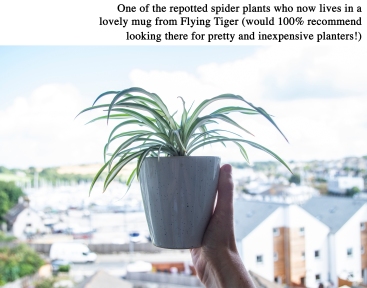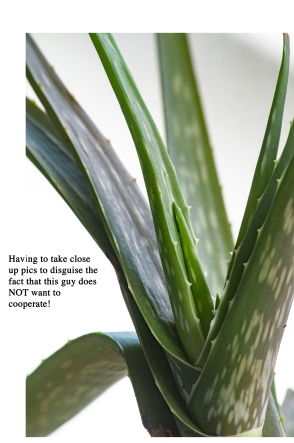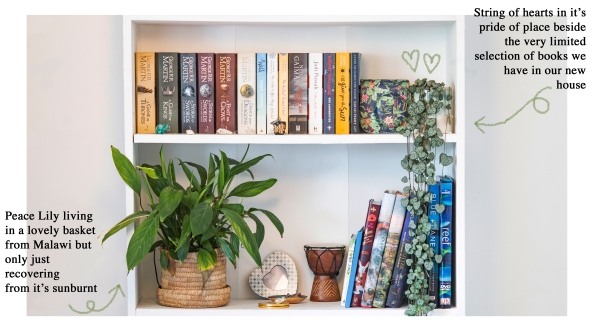Well here we are, blog post two! I actually stuck with it. I think I deserve some kind of medal!
In my last (and first) post, I said that I wanted this blog to be mainly “art things”, so naturally I’m not going to talk about art work at all in this post. Instead I’m going to talk about my other great love; house plants.
Yes, I know, there is really nothing more cliche these days than a plant-loving-millennial but I honestly can’t help it, I actually think I have a problem. (The problem being my dwindling bank balance as my entire income is spent on purchasing pretty plant pots for my ever growing plant family.) Now, I’m not about to claim that I am a great, or even remotely good plant mum; I have no time worrying about if I’ve over or underwater and I don’t have a bedroom that provides good natural light to all of it’s corner. However I have perfected the art of finding plants that will tolerate a fair amount of abuse so this carefully curated list is full of hassle-free plants is perfect for anyone looking to jazz up their room a little bit, as well as some – hopefully helpful – advice on how to make sure they don’t all die the minute you bring them through your front door.
Firstly, the Spider Plant – In my opinion, the spider plant takes the spot of easiest plant to care for that I have ever owned. Perfect for first time plant parents. A lovely friend of mine kindly donated a teeny tiny baby spider plant to me last year, and despite a traumatic start to life, (with a 9 hour coach journey spent in a backpack), this babe has not. stopped. growing. They don’t need overly sunny spots, they hardly ever need repotting and you can water them as and when you remember, though the general rule of thumb with all plants is to let the soil dry before you water again. They also grow baby spiderettes which can be left to dangle as mine are, or repotted by cutting them from the stem and sticking them in some soil – really, it’s that easy.


Common Ivy – Although you’re probably thinking that this is definitely an out door plant that’s not suitable for growing it a pot plant these plants surprisingly a ridiculous easy plant to care for. Last year I had my Ivy hanging from the ceiling, however now, fearing the wrath of our landlord, he’s sitting on top of the DVD cabinet alongside his pals BB-8 and Chewbacca (courtesy of Henry and Rhianna). Similarly to the Spider Plant they are amazing because they’re not fussy. When you look up Ivy Care most websites say that they prefer moist soil but will tolerate dry soil, which I take to mean you can just water them as and when you remember and they probably won’t die. The only thing to watch out for would be their tendency to cling to walls, which looks very edgy but is not edgy when you’re scrubbing dirty marks off your bedroom wall at the end of your tenancy.

Aloe Vera – When cared for correctly they are the perfect funky statement piece for your room with all the additional health benefits that you could want from a house plant. The gel inside their leaves can be used for anything from making face masks to treating sunburn. Some people even drink it in smoothies, though I’m really not sure about that.
However… I do not have a good track record with Aloe Veras. The first Aloe Vera plant that I owned had the same traumatic start as the Spider Plant and It took a lot of coaxing, a lot of plant food, and a lot of moving him about to the prime sunny spots of my remarkably un-sunny student room, for it to somewhat recover. And then I stood on it. Though I suppose, despite having lost almost half it’s leaves, and the rest looking ominously squashed it has pulled through. Just.
The second Aloe I own was bought as a fully grown plant and it insists on permanently looking it’s worst; Nothing I can do can stop this poor babes’ leaves from falling off. I read that Aloe Vera’s need to be watered deeply, however this caused root rot in both of mine, which was fixed by taking them out their soil, cutting off any gross looking roots, repotting, and PRAYING that it will recover. I also read to keep them out of direct sunlight, however when I do this the leaves droop and especially the larger of the two flops over like a rag doll so it seems to me like you just can’t win. However, most people seem fairly successful in their aloe rearing, so if you’d like to risk it then they’re certainly the ideal plant to have.


Spathiphyllum (or Peace Lily) – I bought an incredibly overpriced one from the Eden Project on a trip last year. Mine has had a few up’s and down’s since then, probably due to me accidentally keeping it in bright, direct sunlight, which you’re not supposed to do, but since moving house it has been slowly recovering. One of the best things about Peace Lily’s is they “tell” you if there’s something wrong; if their leaves are drooping, they need watering; if they’re not producing flowers, it’s because they’re not getting enough sunlight; if the leaves start turning brown and dull, it’s had too much sun. I personally like to keep my plants in pretty pots, and not the plastic ones with holes in the bottom, meaning draining can sometimes be an issue, however a tip I’ve picked up that works for most plants is to add a generous layer of pebbles at the bottom of the pot, underneath the soil; if you accidentally over water then it will drain here and the roots won’t get damp and rot.

String of Hearts – most succulents give up the will to live the minute I get my hands on them, so managing to keep this one alive and actually thriving seems to me, a bit of a miracle. Thankfully this plant seems almost as tolerant as the spider plant or ivy, and despite it’s shady home on our shelves the only affect this seems to have had is darker green leaves rather than the highly instagrammable silver colouring that they can have. As with most house plants, the biggest danger is overwatering, so I try to water in tiny dribbles at a time to avoid the treacherous soggy bottom.
 Yucca Elephantipes (Spineless Yucca) – This plant was a true “love at first sight” purchase and although as a plant parent you’re not supposed to have favourites, this babe is definitely mine.
Yucca Elephantipes (Spineless Yucca) – This plant was a true “love at first sight” purchase and although as a plant parent you’re not supposed to have favourites, this babe is definitely mine.
Native to areas around the Caribbean, they’re practically drought-proof and ideal if you’re likely to forget to water it. They prefer bright light and will thrive best outside, but mine has been subjected to living in a corner of our living room and it seems to be doing alright. One thing I would watch out for is their deceptively spiky leaves; I’ve seen a lot of blogs suggesting wearing safety goggles while handling this plant, and while I that might be going a little too far, they are a nightmare to repot.
 Ficus Elastica (or Rubber Plant) – The Ficus plant is probably the most “sensible” member of the family, and they
Ficus Elastica (or Rubber Plant) – The Ficus plant is probably the most “sensible” member of the family, and they
seem to be incredibly “on-trend” at the moment, cropping up on every other blogger’s instagram. I bought mine from Sainsbury’s, partly for the lovely big leaves, but mostly because I liked the pot that has since become too small and been donated to another plant. Although this blog post is about plants that are easy to care for, I’d be tempted to place this one in the slightly more temperamental category as they are one of those plants that need “plenty of light but not too much” (honestly, what does that even mean??) and need to be watered different amounts at different times of the year. This is obviously a bit of a faff to keep track of, but generally it’s safe to assume that you need to water it once a week in the summer, and once every two to three weeks in the winter. There are a few other tips recommended for keeping a Ficus looking healthy, including wiping off their leaves with a damp cloth to stop those big ol’ leaves from collecting dust. Also, keeping them in a pot that is slightly too big encourages them to grow, if you’re hoping for a full on rubber tree!
Pothos – also known as the Devil’s Ivy are yet another plant that has the ability to survive the water-when-you-remember kind of plant parent and a strong contender with the Spider Plant for the top spot of “plants you can’t kill.” They can tolerate anything from bright to dull light, however it is best to keep them out of direct sunlight as this can cause sunburn/yellowing leaves. There are several variations, most featuring variegated leaves, (though mine is not that exciting) and they’re easily propagated by cutting off a vine a sticking it in some water to root. What’s more, they look great in a hanging basket or on a nice shelf – perfect for instagram.


Finally, the Monsteras Obliqua – this is the newest member of my plant family, so really I can’t comment yet on how easy they are to care for because I haven’t been given enough time to kill this one off yet. However I wanted to include in because I love it’s funky leaves and I would recommend it purely based on how edgy it looks.
If you’ve been on any social media platform recently you probably know how popular the swiss cheese plant has become and this smaller version certainly satisfies my love of dangling plants. From what I read, they need moist but not soggy soil and bright but indirect sunlight (to me that just sounds like a plant that’s trying to be difficult.) However it is redeemed by being the kind of plant that indicates when something is not right, for example yellowing leaves can mean it has been overwatered, and brown tipped leaves indicate that the air is too dry and they need to be misted.
So there we have it, a brief (or perhaps not so much) introduction to my plant family, and hopefully some helpful advice on how to not be a plant-killer. If you know of any tips that I haven’t mentioned let me know in the comments, or better yet if you think of any other easy-care plants that I need to invest in I’d love to know that too!
Lots of Love
Nyassa
The photographs featured on this post were very kindly taken by Henry, the rather reluctant other parent to my plants. Thanks you for letting me fill our room with leaves!
